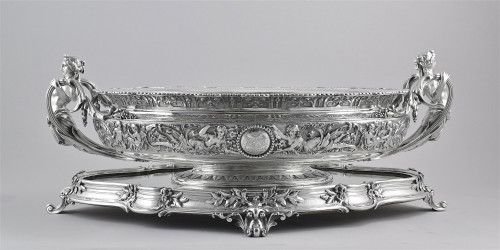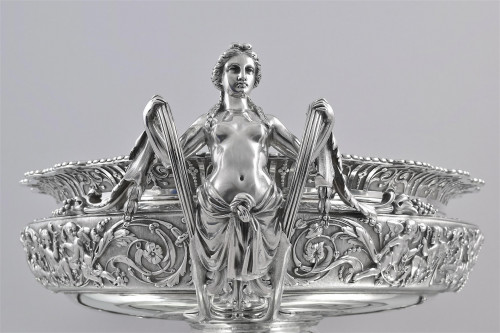ODIOT
While the Maison Odiot can trace its origins back to 1690, it was Jean-Baptiste-Claude Odiot, the grandson of the founder, Jean-Baptiste-Gaspard Odiot, who brought the firm to the attention of the world.
Born in 1763 and becoming a master in 1785, Odiot succeeded his father in the business, steadily building the firm's reputation, coming to a particular notice following the Exposition de l'industrie held in Paris in 1802. Following the bankruptcy, in 1809, of the celebrated neoclassical silversmith Henry Auguste, who at the time was the silversmith to Emperor Napoleon, Odiot was able to purchase many of his models and designs. Odiot, along with Martin-Guillaume Biennais, soon replaced Auguste as Emperor Napoleon's silversmiths ensuring the success of both firms.
Soon Odiot was receiving orders from the French court, including a service made for Napoleon's mother, styled 'Madame Mère' and as well as from across Europe and beyond. The Russian Imperial court's love affair with French silver, most famously realised in the service made for Catherine the Great from the Parisian silversmith Jacques Roettiers and his son Jacques-Nicolas Roettiers in 1770 and subsequently presented to her lover Count Gregory Orloff, continued with commissions from the Russian court to Odiot. Among these important commissions were a massive service for Countess Branicki, the niece of Gregory Potemkin and Count Nikolai Demidoff.
Odiot's work during this period is characterised by strong neoclassical forms, ornamented with cast figural elements, often attached not by the traditional soldering but with the use of bolts and rivets, a method he
While the Maison Odiot can trace its origins back to 1690, it was Jean-Baptiste-Claude Odiot, the grandson of the founder, Jean-Baptiste-Gaspard Odiot, who brought the firm to the attention of the world.
Born in 1763 and becoming a master in 1785, Odiot succeeded his father in the business, steadily building the firm's reputation, coming to a particular notice following the Exposition de l'industrie held in Paris in 1802. Following the bankruptcy, in 1809, of the celebrated neoclassical silversmith Henry Auguste, who at the time was the silversmith to Emperor Napoleon, Odiot was able to purchase many of his models and designs. Odiot, along with Martin-Guillaume Biennais, soon replaced Auguste as Emperor Napoleon's silversmiths ensuring the success of both firms.
Soon Odiot was receiving orders from the French court, including a service made for Napoleon's mother, styled 'Madame Mère' and as well as from across Europe and beyond. The Russian Imperial court's love affair with French silver, most famously realised in the service made for Catherine the Great from the Parisian silversmith Jacques Roettiers and his son Jacques-Nicolas Roettiers in 1770 and subsequently presented to her lover Count Gregory Orloff, continued with commissions from the Russian court to Odiot. Among these important commissions were a massive service for Countess Branicki, the niece of Gregory Potemkin and Count Nikolai Demidoff.
Odiot's work during this period is characterised by strong neoclassical forms, ornamented with cast figural elements, often attached not by the traditional soldering but with the use of bolts and rivets, a method he
inherited from his collaboration with the bronzier Pierre-Philippe Thomire (1751-1843). Having survived the French Empire as well as the Bourbon monarchy, Jean-Baptiste-Claude Odiot retired in 1823 passing the business to his son Charles-Nicolas, who continued to build on the firms success and to enhance their reputation and their list of Royal clients such as François d'Orleans, Prince de Joinville







